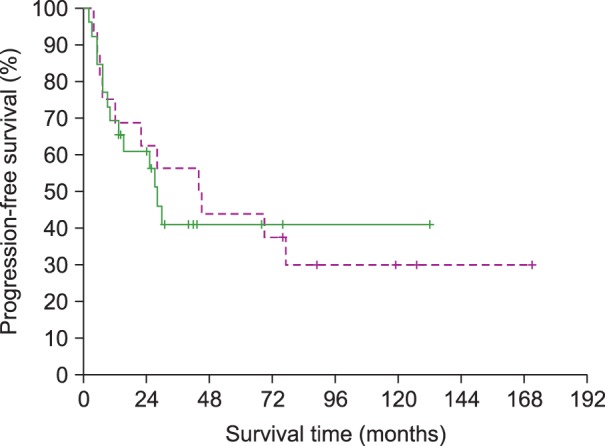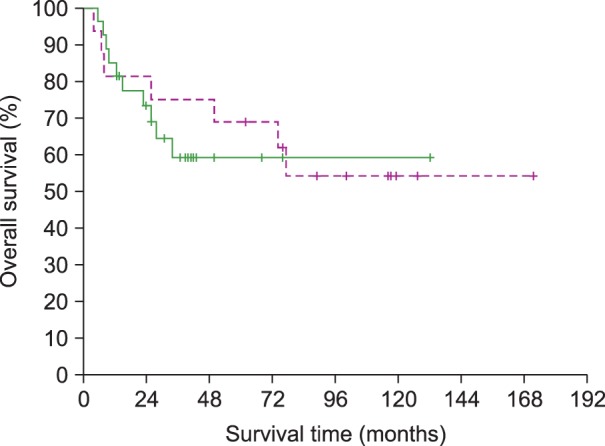Blood Res.
2013 Dec;48(4):274-281. 10.5045/br.2013.48.4.274.
Sequential chemotherapy followed by radiotherapy versus concurrent chemoradiotherapy in patients with stage I/II extranodal natural killer/T-cell lymphoma, nasal type
- Affiliations
-
- 1Department of Radiation Oncology, Korea University Medical Center, Korea University College of Medicine, Seoul, Korea. kcyro@korea.ac.kr
- KMID: 2172875
- DOI: http://doi.org/10.5045/br.2013.48.4.274
Abstract
- BACKGROUND
The purpose of this report is to summarize our clinical experience of patients with stage I/II extranodal natural killer (NK)/T-cell lymphoma, nasal type, treated using sequential chemotherapy followed by radiotherapy (SCRT) or concurrent chemoradiotherapy (CCRT).
METHODS
Forty-three patients with stage I/II extranodal NK/T-cell lymphoma, nasal type, who received SCRT (16 patients) or CCRT (27 patients) were included in the present analysis.
RESULTS
The median follow-up time was 39 months (range, 4-171 months) for all patients, 77 months (range, 4-171 months) for the SCRT group, and 31 months (range, 6-132 months) for the CCRT group. There were no statistically significant differences between the SCRT and CCRT groups with regard to the 3-year progression-free survival (PFS) (56% vs. 41%, P=0.823) and 3-year overall survival (OS) (75% vs. 59%, P=0.670). Univariate analysis revealed that patients with tumors confined to the nasal cavity and patients achieved complete remission had better PFS and OS rates, regardless of the treatment sequence. Multivariate analysis revealed that patients with tumors confined to the nasal cavity and patients aged < or =60 years had better OS rates.
CONCLUSION
The effect of SCRT and CCRT are similar in terms of survival outcomes of patients with stage I/II extranodal NK/T-cell lymphoma, nasal type. Our results show that tumors confined to the nasal cavity and an age < or =60 years were associated with a better prognosis.
MeSH Terms
Figure
Cited by 2 articles
-
Extranodal NK/T cell lymphoma
Seong Hyun Jeong
Blood Res. 2020;55(Supplement):S63-S71. doi: 10.5045/br.2020.S011.Extranodal NK/T cell lymphoma
Seong Hyun Jeong
Blood Res. 2020;55(S1):S63-S71. doi: 10.5045/br.2020.S011.
Reference
-
1. Vose J, Armitage J, Weisenburger D. International peripheral T-cell and natural killer/T-cell lymphoma study: pathology findings and clinical outcomes. J Clin Oncol. 2008; 26:4124–4130. PMID: 18626005.2. Annual report of cancer statistics in Korea in 2010. Sejong-si, Korea: Ministry of Health and Welfare;2012. Accessed August 22, 2013. at http://download.mw.go.kr/front_new/modules/download.jsp?BOARD_ID=1003&CONT_SEQ=283331&FILE_SEQ=131977.3. Kohrt H, Lee M, Advani R. Risk stratification in extranodal natural killer/T-cell lymphoma. Expert Rev Anticancer Ther. 2010; 10:1395–1405. PMID: 20836675.
Article4. Huang MJ, Jiang Y, Liu WP, et al. Early or up-front radiotherapy improved survival of localized extranodal NK/T-cell lymphoma, nasal-type in the upper aerodigestive tract. Int J Radiat Oncol Biol Phys. 2008; 70:166–174. PMID: 17919841.
Article5. Lee J, Cho SG, Chung SM, et al. Retrospective analysis of treatment outcomes for extranodal NK/T-cell lymphoma (ENKL), nasal type, stage I-IIE: single institute experience of combined modality treatment for early localized nasal extranodal NK/T-cell lymphoma (ENKL). Ann Hematol. 2013; 92:333–343. PMID: 23180438.
Article6. Cheson BD, Pfistner B, Juweid ME, et al. Revised response criteria for malignant lymphoma. J Clin Oncol. 2007; 25:579–586. PMID: 17242396.7. Kim SJ, Kim K, Kim BS, et al. Phase II trial of concurrent radiation and weekly cisplatin followed by VIPD chemotherapy in newly diagnosed, stage IE to IIE, nasal, extranodal NK/T-Cell Lymphoma: Consortium for Improving Survival of Lymphoma study. J Clin Oncol. 2009; 27:6027–6032. PMID: 19884539.
Article8. Cox JD, Stetz J, Pajak TF. Toxicity criteria of the Radiation Therapy Oncology Group (RTOG) and the European Organization for Research and Treatment of Cancer (EORTC). Int J Radiat Oncol Biol Phys. 1995; 31:1341–1346. PMID: 7713792.
Article9. Zelenetz AD, Wierda WG, Abramson JS, et al. Non-Hodgkin's lymphomas, version 1.2013. J Natl Compr Canc Netw. 2013; 11:257–272. PMID: 23486452.10. Kim WS, Song SY, Ahn YC, et al. CHOP followed by involved field radiation: is it optimal for localized nasal natural killer/T-cell lymphoma? Ann Oncol. 2001; 12:349–352. PMID: 11332147.
Article11. Wang B, Lu JJ, Ma X, et al. Combined chemotherapy and external beam radiation for stage IE and IIE natural killer T-cell lymphoma of nasal cavity. Leuk Lymphoma. 2007; 48:396–402. PMID: 17325902.
Article12. Kim SJ, Kim BS, Choi CW, et al. Treatment outcome of front-line systemic chemotherapy for localized extranodal NK/T cell lymphoma in nasal and upper aerodigestive tract. Leuk Lymphoma. 2006; 47:1265–1273. PMID: 16923556.13. Kim K, Chie EK, Kim CW, Kim IH, Park CI. Treatment outcome of angiocentric T-cell and NK/T-cell lymphoma, nasal type: radiotherapy versus chemoradiotherapy. Jpn J Clin Oncol. 2005; 35:1–5. PMID: 15681596.
Article14. Yamaguchi M, Tobinai K, Oguchi M, et al. Phase I/II study of concurrent chemoradiotherapy for localized nasal natural killer/T-cell lymphoma: Japan Clinical Oncology Group Study JCOG0211. J Clin Oncol. 2009; 27:5594–5600. PMID: 19805668.
Article15. Lee HJ, Lee SW, Suh C, et al. Treatment outcome of nasal natural killer/T-cell lymphoma. Radiat Oncol J. 2011; 29:174–180. PMID: 22984668.
Article16. Kim TM, Heo DS. Extranodal NK / T-cell lymphoma, nasal type: new staging system and treatment strategies. Cancer Sci. 2009; 100:2242–2248. PMID: 19758393.17. Lee KW, Yun T, Kim DW, et al. First-line ifosfamide, methotrexate, etoposide and prednisolone chemotherapy +/- radiotherapy is active in stage I/II extranodal NK/T-cell lymphoma. Leuk Lymphoma. 2006; 47:1274–1282. PMID: 16923557.
Article18. Li YX, Yao B, Jin J, et al. Radiotherapy as primary treatment for stage IE and IIE nasal natural killer/T-cell lymphoma. J Clin Oncol. 2006; 24:181–189. PMID: 16382127.
Article19. Au WY, Lie AK, Liang R, et al. Autologous stem cell transplantation for nasal NK/T-cell lymphoma: a progress report on its value. Ann Oncol. 2003; 14:1673–1676. PMID: 14581277.
Article20. Parsons JT, Mendenhall WM, Mancuso AA, Cassisi NJ, Million RR. Malignant tumors of the nasal cavity and ethmoid and sphenoid sinuses. Int J Radiat Oncol Biol Phys. 1988; 14:11–22. PMID: 3335447.
Article21. Li YX, Fang H, Liu QF, et al. Clinical features and treatment outcome of nasal-type NK/T-cell lymphoma of Waldeyer ring. Blood. 2008; 112:3057–3064. PMID: 18676879.
Article
- Full Text Links
- Actions
-
Cited
- CITED
-
- Close
- Share
- Similar articles
-
- Metachronous extranodal natural killer/T-cell lymphoma of nasal type and primary testicular lymphoma
- Extranodal NK/T cell lymphoma
- Treatment outcome of nasal natural killer/T-cell lymphoma
- A Case of Nasal Type NK/T-cell Lymphoma
- A Case of Extranodal Natural Killer/T Cell Lymphoma Combined With Actinomycosis



